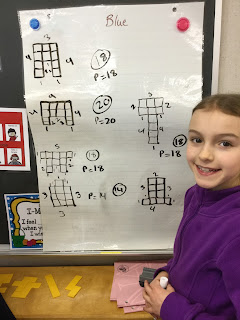One of my favourite things to teach is nets. The way I teach it is very different to the way I was taught it. Basically, I remember having to look at something like this:
and then say which of these were nets of a cube. As my spatial reasoning was net well-developed, I had trouble with this type of question. When I began teaching, I would 'teach' nets by getting students to cut out and glue something like this:
Whilst this was an improvement on how I learnt, it was all a bit messy and time-consuming. The way I teach now is much better as I get the students to use polydrons. These are two-dimensional shapes that click together to form nets that can be folded together to form a solid.
I visited two Grade 5 classes recently and, having explained what a net was, challenged the students to find as many nets of a cube as they could. The students were randomly grouped into threes and, to help them record their results, I provided one sheet of grid paper to each group.Each group got stuck into the challenge immediately. The wonderful thing about polydrons is that it is that it is so quick for students to either prove that their net works:
It is a perfect opportunity to stop the class and get their views: some say they are the same, others say that they are different. I can then tell them that to a mathematician, they are the same as they are congruent: they are exactly the same size and shape. I can even show this to the students by reflecting or rotating the nets so that they coincide.
Sooner or later, the students ask me how many nets there are so I tell them that there are eleven. If any student find this net, I make sure that they know that it is my favourite net:
At the end of class, we then summarised our results: success! we had found all eleven.
When students found this net, I made sure that they knew that it was my favourite:
Having done all this investigation, students will now be in a better position to look at the first picture at the top of this post and use their spatial reasoning to decide which of these are nets.

























































